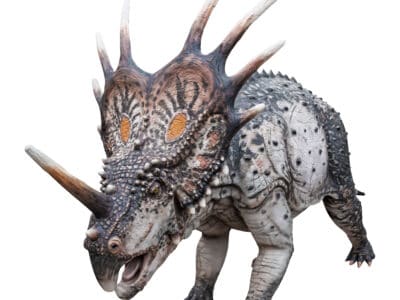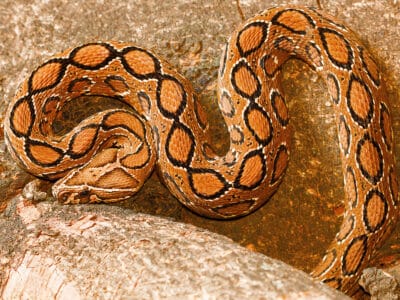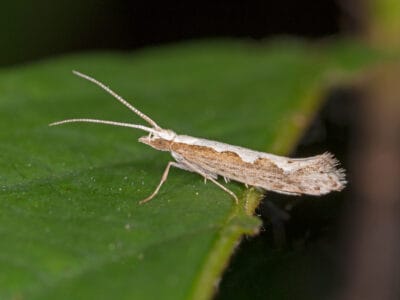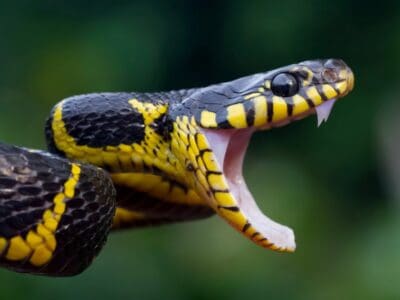Southern Pacific Rattlesnake
.jumbotron {
background-image: url(“https://a-z-animals.com/media/2022/03/crotalus-helleri-southern-pac-shutterstock_1994130689-400×300.jpg”);
}
}
@media only screen and (min-width: 641px) and (max-width: 920px) {
.jumbotron {
background-image: url(“https://a-z-animals.com/media/2022/03/crotalus-helleri-southern-pac-shutterstock_1994130689-470×370.jpg”);
}
}
@media only screen and (min-width: 921px) {
.jumbotron {
background-image: url(“https://a-z-animals.com/media/2022/03/crotalus-helleri-southern-pac-shutterstock_1994130689.jpg”);
}
}
Southern Pacific Rattlesnake
C. helleri
Southern Pacific rattlesnakes hibernate in dens that hold hundreds of snakes.
Southern Pacific Rattlesnake Scientific Classification
- Kingdom
- Animalia
- Phylum
- Chordata
- Class
- Reptilia
- Order
- Squamata
- Family
- Viperidae
- Genus
- Crotalus
- Scientific Name
- C. helleri
Read our Complete Guide to Classification of Animals.
Southern Pacific Rattlesnake Conservation Status
Southern Pacific Rattlesnake Facts
- Prey
- Lizards, birds, snakes, frogs, and small mammals including rats, mice, rabbits, and ground squirrels.
- Main Prey
- Rats, mice, rabbits, and ground squirrels.
- Name Of Young
- neonate
- Group Behavior
-
- Solitary
- Fun Fact
- Southern Pacific rattlesnakes hibernate in dens that hold hundreds of snakes.
- Biggest Threat
- habitat loss and human encounters
- Most Distinctive Feature
- Rattle composed of interlocking keratin links.
- Distinctive Feature
- Large, triangular head and narrow neck.
- Habitat
- scrub brush, coastal sage, rocky hills
- Predators
- Coyotes, roadrunners, hawks, owls.
- Diet
- Carnivore
- Lifestyle
-
- Nocturnal
- Crepuscular
- Nocturnal/Crepuscular
- or Nocturnal Depending on Region and Season
- Common Name
- Southern Pacific Rattlesnake
- Location
- Southern California from Santa Barbara County south to northern Baja California and the Santa Catalina Islands.
Southern Pacific Rattlesnake Physical Characteristics
- Color
-
- Brown
- Grey
- Black
- Dark Brown
- Skin Type
- Scales
- Length
- 30-44 inches
- Venomous
- Yes
- Aggression
- Medium
This post may contain affiliate links to our partners like Chewy, Amazon, and others. Purchasing through these helps us further the A-Z Animals mission to educate about the world’s species..

Discover alligator-eating snakes, spiders larger than your phone, and 1000 more incredible animals in our daily FREE email.
.photo-gallery {
–margin: 0px auto 0px;
–padding: 0px 0px 0px 0px;
}
.gallery-link {
background-image: url(“https://a-z-animals.com/media/2022/03/crotalus-helleri-southern-pac-shutterstock_1994130689-1024×535.jpg”);
background-repeat: no-repeat;
background-size: cover;
background-position: center;
height: 500px;
justify-content: center;
text-align: center;
align-items: center;
display: flex;
border: 2px solid #000;
}
.gallery-link img {
height: 50%;
}
@media only screen and (max-width: 768px) {
.gallery-link {
height: 300px !important;
}
}
View all of the Southern Pacific Rattlesnake images!
The southern Pacific rattlesnake is known as the “people-biting rattlesnake” because it is responsible for most snakebites between Los Angeles and San Diego.
This chunky rattlesnake lives in the southern portion of California, from Santa Barbara south into northern Baja California, Mexico. Its fierce expression hides a somewhat jumpy tendency, making it more likely to bite than its western diamondback rattlesnake cousin.
3 Amazing Facts About Southern Pacific Rattlesnakes
- Juveniles of this species have weaker venom than adults. Scientists believe this is because mature snakes take larger prey, which requires a more potent venom.
- Rattlesnakes’ loreal pits allow them to see infrared light. Scientists used information gained from research to improve night vision technology.
- Unlike species whose populations are shrinking, Southern Pacific rattlesnakes seem to be expanding their range.
- Rattlesnakes do not always rattle a warning, and if you surprise one, it may strike before you know it’s there.
Where to Find Southern Pacific Rattlesnakes
This snake has a small native range, from southern California to northern Baja California, Mexico; they also occur on a couple of Santa Catalina Islands. It lives in various habitats, including grasslands, forests, rocky hillsides, and coastal scrub.
button.pulse {
transform: scale(1); animation: pulse 2s infinite;
box-shadow: 0 0 0 0 rgba(11, 247, 25, 1);
}
@keyframes pulse {
0% { transform: scale(0.90); box-shadow: 0 0 0 0 rgba(11, 247, 25, 0.5); }
60% { transform: scale(1); box-shadow: 0 0 0 15px rgba(11, 247, 25, 0); }
100% { transform: scale(0.90); box-shadow: 0 0 0 0 rgba(11, 247, 25, 0); }
}
Southern Pacific rattlesnakes are nocturnal during the hotter summer nights, but they may also be active in the spring and fall during the day. These snakes often spend the winter months in large dens, and sometimes hundreds of snakes share the same space.
Pitvipers like the Southern Pacific rattlesnake are more sedentary than other snakes. Instead of actively hunting, they coil up in one location for several days, waiting for prey to wander past their hideout.
Southern Pacific Rattlesnake: Scientific Name
Southern Pacific rattlesnakes are pitvipers in the Viperidae family. Their scientific name, Crotalus helleri, is both Greek (Crotalus means rattle) and honoring American zoologist Edmund Heller (1875-1939) with the specific name (helleri).
There are about 32 rattlesnake species, and all of them live in the Americas. Rattlesnakes are part of the subfamily Crotalinae, including other pitvipers such as the cottonmouth and lancehead. Pitvipers have heat-sensing organs between their nostrils and eyes. These organs are called loreal pits, and they show the snake differences in temperature, which enables them to find their prey in the dark. It’s part of the reason they’re more active at night than during the day.
Southern Pacific Rattlesnake Population and Conservation Status
The International Union for the Conservation of Nature hasn’t assessed this species for inclusion on the IUCN Redlist. However, anecdotal evidence from naturalists indicates that they may be expanding their range. California doesn’t consider them threatened, and their population appears stable.
One of the biggest threats to their survival is humans, who kill them out of fear. These snakes are also victims of vehicles while traveling across roads. They are also trying to adapt to a changing environment, and habitat loss is a problem. Predation by animals such as coyotes, roadrunners, hawks, and kingsnakes is another challenge.
Southern Pacific rattlesnakes’ breeding season begins when they emerge from hibernation in the spring and typically lasts for a couple of months. After successful mating, females carry the fertilized eggs within their bodies for about three months, producing 8-10 neonates measuring approximately 6-10 inches. The babies stay near their birthplace for several days and up to two weeks until they shed for the first time.
Appearance and Description: Identifying Southern Pacific Rattlesnakes
These snakes are large-bodied with stubby tails. Southern Pacific rattlesnakes have a light base color ranging from light gray to dark brown; their backs have dark-rimmed blotches with light bands in between them. Like all rattlesnakes, their heads are big and spade-shaped with skinny necks. Adults usually measure 2 1/2 to 3 feet, but sometimes you’ll find one that’s four feet long. The juveniles have a bright yellow or green tail and a button at the end.
Snakes that live on the Santa Catalina islands are darker than most of their mainland cousins, but southern Pacific rattlesnakes living near Idylwild often have dark, almost black coloring. Their pattern is nearly impossible to see in some individuals.
These snakes have hooded eyes, so looking from above, you cannot see their eyes easily. They also have a diagonal stripe coming from their eyes down towards the back of their mouths. Their pupils are elliptical, and they have heat-sensing organs between their nostrils and eyes.
Some people believe that rattlesnakes may be evolving away from the rattle, but there’s no evidence to support the idea. It’s more likely that snakes without rattles have had them broken. However, in some cases, the snake may lose its tail in an accident. Identifying them without a rattle is a little more complicated, but learning to recognize the head and body shape and markings is the most reliable option.
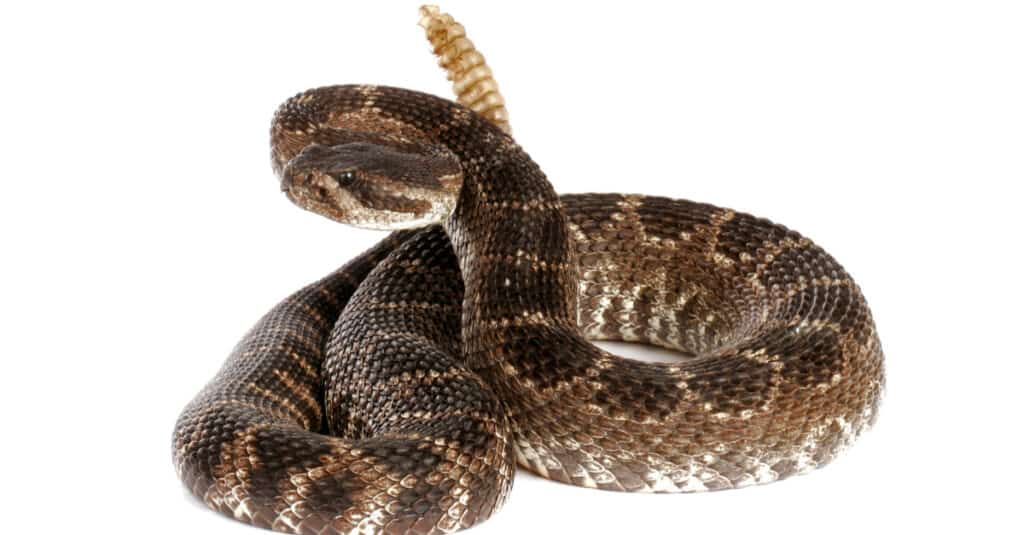
Audrey Snider-Bell/Shutterstock.com
Pictures and Videos of Southern Pacific Rattlesnakes
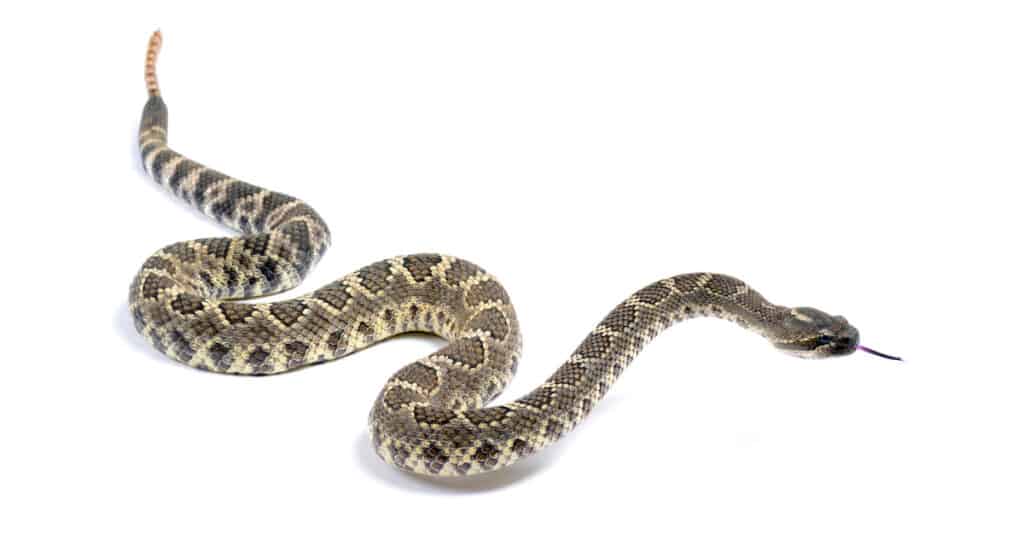
Audrey Snider-Bell/Shutterstock.com
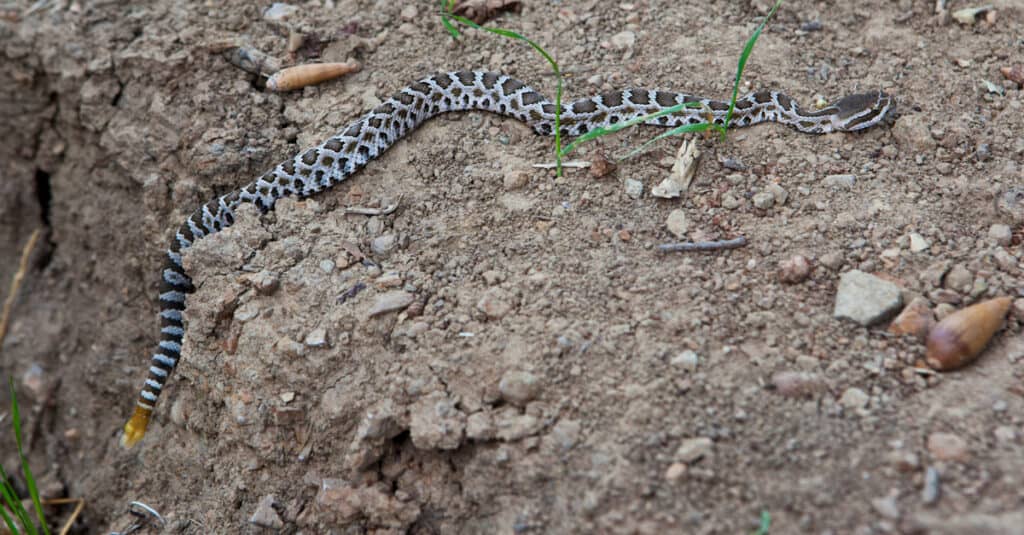
Doug Meek/Shutterstock.com
Venom: How Dangerous are Southern Pacific Rattlesnakes
Surprisingly, these slightly smaller rattlesnakes are more dangerous than their larger western diamondback rattlesnake cousins. They are responsible for most rattlesnake bites in the coastal areas from Los Angeles south, yet the antivenom available isn’t made using their venom. In addition, their venom varies depending upon both their age and location, which makes treating envenomations from southern Pacific rattlesnakes a more significant challenge.
According to a 2014 study, the Catalina Island populations had more blood-destroying toxins than their mainland counterparts, which exhibited more neurotoxins. Additionally, younger snakes have less potent venom than mature snakes.
The wide variance in venom content makes treating rattlesnake bites difficult. However, scientists are working hard to understand those differences, to make treating all snakebites more effective.
Behavior and Humans
As ambush predators, most encounters happen because someone stumbled upon them. These snakes don’t move much unless they have a need.
This species is widespread in Southern California. Hikers and others who spend time in the hills and scrub brush are more likely to encounter a southern Pacific rattlesnake. Even though they’re a little prickly and prone to striking, these snakes still prefer escape over confrontation.
Southern Pacific rattlesnakes are vital to the environment. They and other snakes are natural rodent control that performs a service. They may be a little scary, but they’ll get out of your way, given a chance.
View all 186 animals that start with S
Southern Pacific Rattlesnake FAQs (Frequently Asked Questions)
Are southern Pacific rattlesnakes venomous?
Yes, and they seem to be more jumpy than other species. According to keepers, they are more likely to strike than other rattlesnakes.
What are their natural predators?
Owls, hawks, coyotes, and roadrunners all prey on this snake. Additionally, king snakes include this species in their diet.
How do they hunt?
Primarily, southern Pacific rattlesnakes are ambush predators. They coil up and wait for prey to come to them. However, they also sometimes actively hunt.
What do southern Pacific rattlesnakes eat?
Like most rattlesnakes, they’re generalist carnivores. This species eats frogs, lizards, rats, mice, rabbits, and ground squirrels.
Sources
- Aquarium of the Pacific, Available here: https://www.aquariumofpacific.org/onlinelearningcenter/species/southern_pacific_rattlesnake
- Ohai Valley Land Conservatory, Available here: https://ovlc.org/southern-pacific-rattlesnake/
- Save the Buzztails, Available here: https://www.savethebuzztails.org/species-accounts/Southern-Pacific-Rattlesnake
- Reptile Database, Available here: https://reptile-database.reptarium.cz/species?genus=Crotalus&species=helleri&search_param=%28%28search%3D%27crotalus+helleri%27%29%29
- Taxonomy Browser | National Center for Biotechnology Information, Available here: https://www.ncbi.nlm.nih.gov/Taxonomy/Browser/wwwtax.cgi?mode=Info&id=8741&lvl=3&lin=f&keep=1&srchmode=1&unlock
- Intraspecific venom variation in the medically significant Southern Pacific Rattlesnake (Crotalus oreganus helleri): biodiscovery, clinical and evolutionary implications | Kartik Sunagar, Eivind A B Undheim, Holger Scheib, Eric C K Gren, Chip Cochran, Carl E Person, Ivan Koludarov, Wayne Kelln, William K Hayes, Glenn F King, Agosthino Antunes, Bryan Grieg Fry, Available here: https://pubmed.ncbi.nlm.nih.gov/24463169/










